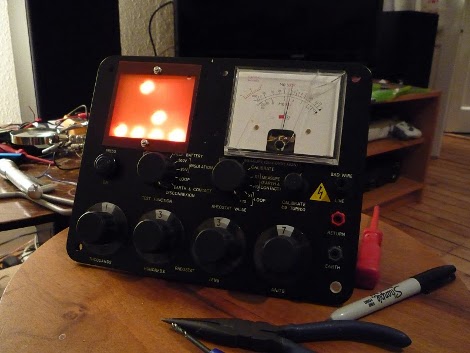
[Kieran] let us know about his hybrid analog/binary clock. The circuitry behind the clock is nothing too new. An Arduino combined with a Chronodot to produce an accurate clock. What we really enjoyed however was the creative implementation of an old British Telecom Linesman’s Multimeter as the case. The analog meter acts as the seconds hand, while a another display made of LEDs diffused with stripboard is the binary clock. The end product is nothing short of ingenuitive.















That is a BEAUTIFUL object. I really, really want one.
love the setting 1337 on the dials
That is INGENIOUS.
;-)
very very nice!
Awesome!
Too bad he didn’t use the dials w/stepper motors for a 3rd display,,, Guess theres always v2.0!
For a clock, why have the arduino pole the Dot at all? The ChronoDot has the optional 1Hz pulse on SQW, that could be an interrupt to do all of the rest. I guess with PWM for the analog gauge it doesn’t matter, but power saving for other pieces could be useful.
heh, no offence to Quin or Jakob, but first it was “poll”-dancing robots and now we’re “pole”-ing our chronodots! I love it! x}
Oh yeah, forgot… The clock’s cool, too!
oh for fuck’s sake! “ingenuitive”?
Quin: the original plan was to use the SQW pin to make a relay tick every second but I ditched that idea when it turned out the most durable relay I could get would only last 3 months MTBF. I2C seems the normal way to speak to the Chronodot…
atrain: I thought about making the knobs at the bottom into a 3rd display,.. Mk3 maybe. Makes it too easy to read too ;-)
“That is a BEAUTIFUL object. I really, really want one.”
it probally was before someone gutted it and put yet another binary clock on it
me no understand why binary clocks are STILL popular
@Kieran: Good reason, that. Could still use it to drive a small piezo or speaker, getting the tick-tock effect. Wouldn’t shake the clock like a good heavy relay would.
@Amos: What can I say, it was late, I was wasted.
@Kieran: Nice work!!! Regarding the relay mtbf, I’d say those ratings are based primarily on contact failure… If you are using the relay as a simple sounding device, it should last much longer. I employed the same effect in a nixie clock project, and it’s still ticking 10 years later.
Ok, I say the MTBF was the reason for not using it… also I couldn’t work out how to enable the SQW pin and the relays I got were a bit noisy… Still, all ideas for Mk3!
As far as me having destroyed the multimeter, Osgeld, it was free, useless and taking up space, now its useful and I’ve learnt something in the process. If you can think of how it could be better used (Testing 1950’s phone lines?) then I have another one spare you’re welcome to.
When you make your binary clock, would you make it big-endian or little-endian?